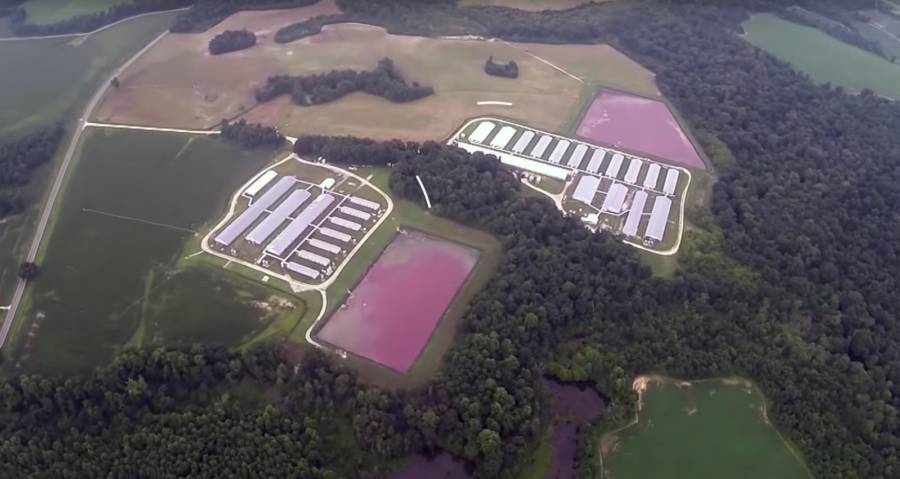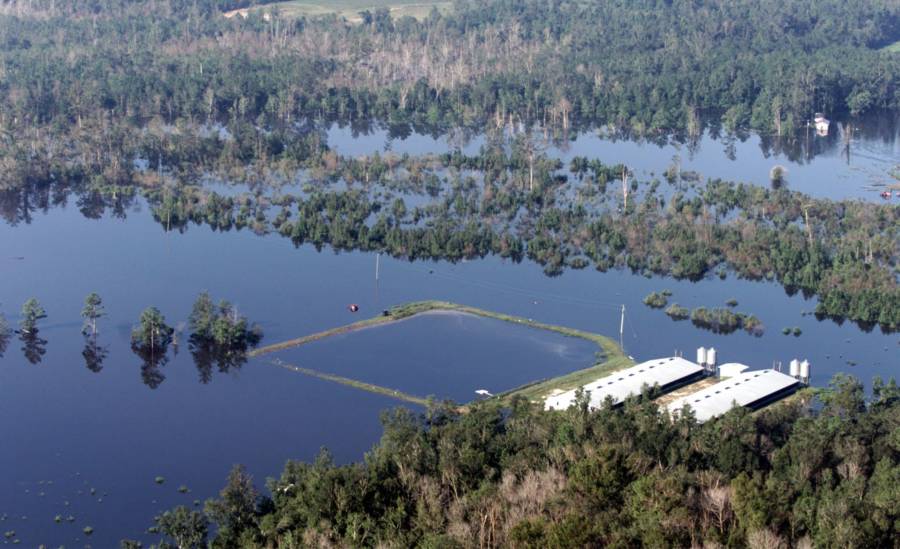As Hurricane Florence dumps dozens of inches of rain onto North Carolina, many are wondering if the state's pig manure lagoons will be able to withstand the downpours — without contaminating their drinking water.

ReutersA group of pigs swim in overflowing manure pits during the aftermath of Hurricane Floyd in 1999.
As Hurricane Florence batters the East Coast, residents in North Carolina have one unusual hurricane threat to deal with: hog waste.
North Carolina is the second largest producer of pork in the country and has thousands of hog farms on its east coast which is the area in the storm’s direct path. With a large number of pigs comes a large amount of pig waste, which the farms store in vast “lagoons,” according to the Washington Post.
With Florence already dropping more than 18 inches of rain down on the state, there’s one question on everyone’s minds: what’s going to happen to these pig waste lagoons if they overflow?

Environmental Working GroupA map of hog farms and animal waste lagoons in eastern North Carolina.
The area’s large number of hog farmers store the waste from their animals in giant pits of liquified and treated manure that they later spray on their crops. It is a useful technique even on a rainy day, but when giant storms threaten to overflow the lagoons, problems arise.
The fear is that the pits will be so inundated with rainwater that the manure will overflow and wash into rivers and nearby lands, and eventually contaminate the drinking water.
“When you have a swine lagoon breach, it is going to have a catastrophic impact on the river,” Kemp Burdette, with the Cape Fear River Watch, told CNN. “We are going to see serious water quality problems.”

YouTubeTwo pig waste lagoons shown from above.
Hurricane Florence is not the first time that the North Carolina area has had to worry about this problem. According to the Washington Post, during Hurricane Floyd in 1999, several lagoons spilled over and contaminated nearby land and killed thousands of hogs.
After the devastating storm, the state offered to buy out the farms that were in the dangerous flood zones and since then, the hog farmers have been working hard to make their lagoons safer from floods.

JOHN ALTHOUSE/AFP/Getty ImagesA flooded pig farm in Burgaw, N.C. on Sept. 18, 1999 after Hurricane Floyd hit the area.
When Hurricane Matthew hit the state in 2016 just 14 hog waste lagoons overflowed. When compared to the 55 from Floyd, it looks like progress. In 2016, there were over 3,700 lagoons that properly withstood the floodwaters from the storm, according to the Washington Post.
A common practice in storm preparation for the hog farmers is to lower their lagoons’ levels as much as possible beforehand to make room for the potential downpours. According to NPR, experts at North Carolina State University say that if farmers can do this before Florence comes, the lagoons should be able to withstand nearly three feet of rainwater.
Some weather reports estimate that Florence could drop 40 inches of rain on the area.
One local farmer told NPR that she isn’t sure whether lowering the lagoons before the storm will do enough to prevent overflow.
“We don’t really know,” she said. “I mean, we try to pump down as much as we can, but after that, it’s kind of in God’s hands. We’re kind of at the mercy of the storm.”
Even if the levels can be lowered enough, some say that the runoff from the storm is going to move the manure that was sprayed into unwanted areas.
“Everything that’s been sprayed on the fields is going to leave with the runoff anyway,” Soren Rundquist, the director of spatial analysis for the Environmental Working Group, told CNN. “So pumping it might move it from over here to over there, but it doesn’t have a practical effect.”
So far, 150 people have needed to be rescued from Florence’s dangerous flood waters and a million others evacuated before the storm. However, those returning after the storm don’t know whether or not they will be coming home to clean drinking water.
Next, take a look at these haunting photos of the Galveston Hurricane of 1900, the deadliest disaster in American history. After that, revisit New Orleans 10 years after Hurricane Katrina.





